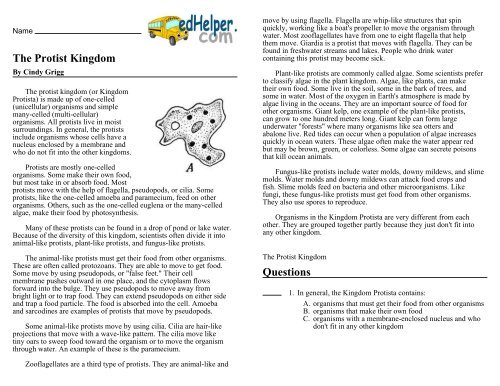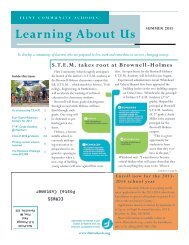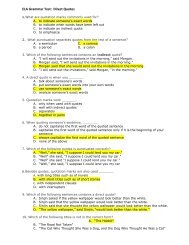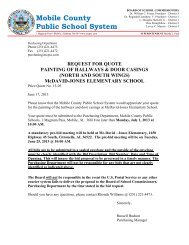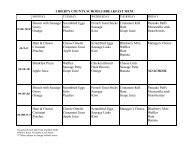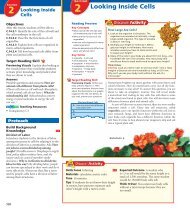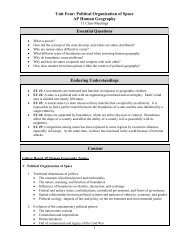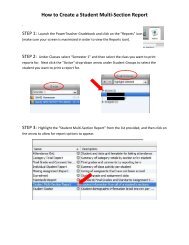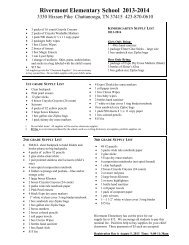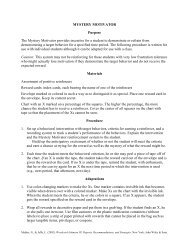The Protist Kingdom Questions
The Protist Kingdom Questions
The Protist Kingdom Questions
Create successful ePaper yourself
Turn your PDF publications into a flip-book with our unique Google optimized e-Paper software.
Name<br />
<strong>The</strong> <strong>Protist</strong> <strong>Kingdom</strong><br />
By Cindy Grigg<br />
<strong>The</strong> protist kingdom (or <strong>Kingdom</strong><br />
<strong>Protist</strong>a) is made up of one-celled<br />
(unicellular) organisms and simple<br />
many-celled (multi-cellular)<br />
organisms. All protists live in moist<br />
surroundings. In general, the protists<br />
include organisms whose cells have a<br />
nucleus enclosed by a membrane and<br />
who do not fit into the other kingdoms.<br />
<strong>Protist</strong>s are mostly one-celled<br />
organisms. Some make their own food,<br />
but most take in or absorb food. Most<br />
protists move with the help of flagella, pseudopods, or cilia. Some<br />
protists, like the one-celled amoeba and paramecium, feed on other<br />
organisms. Others, such as the one-celled euglena or the many-celled<br />
algae, make their food by photosynthesis.<br />
Many of these protists can be found in a drop of pond or lake water.<br />
Because of the diversity of this kingdom, scientists often divide it into<br />
animal-like protists, plant-like protists, and fungus-like protists.<br />
<strong>The</strong> animal-like protists must get their food from other organisms.<br />
<strong>The</strong>se are often called protozoans. <strong>The</strong>y are able to move to get food.<br />
Some move by using pseudopods, or "false feet." <strong>The</strong>ir cell<br />
membrane pushes outward in one place, and the cytoplasm flows<br />
forward into the bulge. <strong>The</strong>y use pseudopods to move away from<br />
bright light or to trap food. <strong>The</strong>y can extend pseudopods on either side<br />
and trap a food particle. <strong>The</strong> food is absorbed into the cell. Amoeba<br />
and sarcodines are examples of protists that move by pseudopods.<br />
Some animal-like protists move by using cilia. Cilia are hair-like<br />
projections that move with a wave-like pattern. <strong>The</strong> cilia move like<br />
tiny oars to sweep food toward the organism or to move the organism<br />
through water. An example of these is the paramecium.<br />
move by using flagella. Flagella are whip-like structures that spin<br />
quickly, working like a boat's propeller to move the organism through<br />
water. Most zooflagellates have from one to eight flagella that help<br />
them move. Giardia is a protist that moves with flagella. <strong>The</strong>y can be<br />
found in freshwater streams and lakes. People who drink water<br />
containing this protist may become sick.<br />
Plant-like protists are commonly called algae. Some scientists prefer<br />
to classify algae in the plant kingdom. Algae, like plants, can make<br />
their own food. Some live in the soil, some in the bark of trees, and<br />
some in water. Most of the oxygen in Earth's atmosphere is made by<br />
algae living in the oceans. <strong>The</strong>y are an important source of food for<br />
other organisms. Giant kelp, one example of the plant-like protists,<br />
can grow to one hundred meters long. Giant kelp can form large<br />
underwater "forests" where many organisms like sea otters and<br />
abalone live. Red tides can occur when a population of algae increases<br />
quickly in ocean waters. <strong>The</strong>se algae often make the water appear red<br />
but may be brown, green, or colorless. Some algae can secrete poisons<br />
that kill ocean animals.<br />
Fungus-like protists include water molds, downy mildews, and slime<br />
molds. Water molds and downy mildews can attack food crops and<br />
fish. Slime molds feed on bacteria and other microorganisms. Like<br />
fungi, these fungus-like protists must get food from other organisms.<br />
<strong>The</strong>y also use spores to reproduce.<br />
Organisms in the <strong>Kingdom</strong> <strong>Protist</strong>a are very different from each<br />
other. <strong>The</strong>y are grouped together partly because they just don't fit into<br />
any other kingdom.<br />
<strong>The</strong> <strong>Protist</strong> <strong>Kingdom</strong><br />
<strong>Questions</strong><br />
1. In general, the <strong>Kingdom</strong> <strong>Protist</strong>a contains:<br />
A. organisms that must get their food from other organisms<br />
B. organisms that make their own food<br />
C. organisms with a membrane-enclosed nucleus and who<br />
don't fit in any other kingdom<br />
Zooflagellates are a third type of protists. <strong>The</strong>y are animal-like and
Name<br />
Some scientists classify algae as protists, while some classify algae as<br />
plants. Choose the kingdom you believe algae should be classified in.<br />
Support your answer with details from the reading passage. Explain<br />
why it should not be in the other kingdom.<br />
2. Most protists move with the help of:<br />
A. euglena and amoeba<br />
B. muscles and bones<br />
C. cilia, flagella, or pseudopods<br />
3. You would find most protists living in:<br />
A. Antarctica<br />
B. a desert<br />
C. a moist environment<br />
4. What does pseudopod mean?<br />
A. false animal<br />
B. making seed pods<br />
C. false foot<br />
5. What are pseudopods used for?<br />
A. moving<br />
B. trapping food<br />
C. both a and b<br />
6. What are cilia?<br />
A. hair-like projections<br />
B. a type of chemical in the cell<br />
C. silly feet<br />
7. What are flagella?<br />
A. flags that show protists where to go<br />
B. whip-like structures that spin quickly<br />
C. false feet
Name<br />
How are protists like plants? How are they unlike plants? Write a<br />
paragraph to explain.


